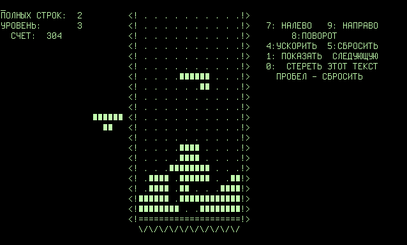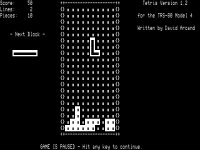tempest
Veteran Member
Is there any real reason to upgrade a Model 4 from 64K to 128K? I have the non-gate array version so it's a bit trickier to do this. Also, are the needed memory chips and PAL (or GAL) readily available?
Disk-loading games usually needed 32k... but, yeah, outside of a few games written for the high-res board were there any games for the Model 4 that didn't run in Model III mode? Maybe a text adventure or two?
I believe a problem with the Model 4 is that the "pixels" in the 2x3 block characters aren't the same size (the 3rd row is a different height) like they are on the Model I/III . This would make anything moving around on the screen look unusual. However it didn't stop Tetris from being written for the Model 4 (http://www.classiccmp.org/cpmarchives/trs80/Software/Model 4/T/), and I can't see a Model I/III version on that web site.
I also upgraded mine (a NGA model too) and it was a real PITA. No GAL worked for me and it didn't worked until I switched to use a real PAL IC.
Really? I remember playing a bunch of classic TRS-80 games on a Model 4 at a show years ago (a bunch of Big Five stuff) and didn't see anything unusual. I'd be interested in seeing a comparison though, as now I'm kind of curious.
That's because classic TRS-80 games run in Model I/III mode, with 64x16 text and equal size graphics blocks. It's the Model 4-exclusive 80x24 text mode that has the unequal size graphics blocks.
However it didn't stop Tetris from being written for the Model 4 (http://www.classiccmp.org/cpmarchives/trs80/Software/Model 4/T/), and I can't see a Model I/III version on that web site.

So Model I/III games will run in the regular 64x16 mode on a 4? That's what I figured, otherwise people would have complained.
A standard Tetris grid is 10x20 so a Model 4 version of Tetris would probably just use the solid white character to represent a block so the shaved-off low pixels wouldn't matter. This would be one very rare edge case where the Model 4's video system makes writing an "action game" easier than the Model I/III's layout.

Yeah you're right, the blocks just move one full line at a time so there isn't any weirdness as it moves down the screen, although it does use hollowed blocks so you can see the different pixel heights. See attached.
I remember sort of wondering why Tandy didn't tweak the system to even that out a bit; you know, maybe make it so in Model 4 mode the upper and lower blocks were 3 pixels tall and the middle row 4.
... The Model III mode would use the full 12 vertical pixel lines for each character, and the Model 4 mode would just use the first 10 pixel lines.
...
Interestingly the 4 tech manual notes that it's in principle possible to have 2 video pages of the 64x16 mode thanks to it only using half of the 2k video SRAM. I wonder if *anything* leveraged that functionality. (It's not clear to me, however, if it's possible to write to that second page if the 4 is in III mode... so you'd have to have the system set for the 4 memory map with the III's screen layout?!)
Wasn't there one version of MultiDOS for Model 4 that did an 80x24 screen but was Model III memory-map compatible? It would have used this functionality.
EDIT: On the subject of the screen geometry and the pixels-per-character business, it should be noted that the Model 4 used the same exact CRTC part used for the Model III high-resolution graphics board (26-1125) which drives the Model III's CRT at 640x240 pixels. Now, it's a bit of a dilemma as to which came first, 26-1125 or Project R (aka Model 4), but it's very likely that they were being developed around the same time, and that there was a desire to amortize the mask setup fee for the CRTC across something with a higher volume potential than 26-1125. Now, while the monitor might possibly have been able to do a 640x288 display, this would have definitely upped the dot clock, which was already pushing some limits as I recall.
A couple of links for you: The TRS-80.ORG page on it: http://www.trs-80.org/multidos/ and the TRS-80.COM page for it: http://www.trs-80.com/wordpress/multidos/ There are disk images available for download from the trs-80.com pages.You know, now that you mention it I remember reading an ad for that in an '80 Micro but I've never seen it in the flesh. I wonder how well it actually worked. (Maybe I need to get off my rear and make a floppy disk imaging station so I can try it, assuming not every copy of it was lost to history before ending up as a disk image.)
Tandy's motivation was a bit more mundane; at least on the Model II it is possible to cause the monitor board to self-destruct with improper video timings (a real 'halt-and-catch-fire' mode!), and it might be possible on the III/4 as well. But the 80/64 mode switching is implemented with the 6835/68045's masked registers directly, using an input on the CRTC and without needing to reprogram the CRTC when you wanted to switch between modes. Using a straight 6845 is possible, but you need a bit of support for it in both the ROM and the DOS. MAD Software's XROM/XDROM products do a proper CRTC program for 6845, and LS-DOS does a proper 6845 init for 80x24 mode as far as I recall.I'd forgotten about how the 4 used that funky masked version of the CRTC instead of a plain 6845. I imagine that would at least partially rule out the possibility of writing funky demoware that abuses the CRTC ala "No Pets Allowed", wouldn't it. Darn.
